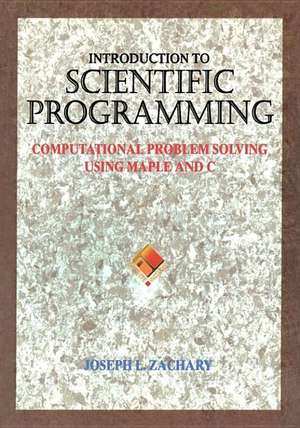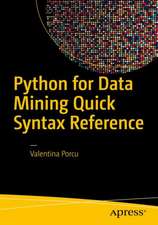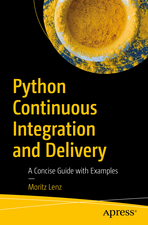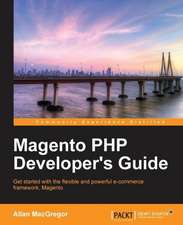Introduction to Scientific Programming: Computational Problem Solving Using Maple and C
Autor Joseph L. Zacharyen Limba Engleză Hardback – 26 sep 1996
| Toate formatele și edițiile | Preț | Express |
|---|---|---|
| Paperback (2) | 340.82 lei 6-8 săpt. | |
| Springer – 27 ian 2014 | 340.82 lei 6-8 săpt. | |
| Springer – 21 feb 2014 | 401.24 lei 6-8 săpt. | |
| Hardback (1) | 340.56 lei 38-44 zile | |
| Springer – 26 sep 1996 | 340.56 lei 38-44 zile |
Preț: 340.56 lei
Preț vechi: 425.69 lei
-20% Nou
Puncte Express: 511
Preț estimativ în valută:
65.17€ • 67.79$ • 53.81£
65.17€ • 67.79$ • 53.81£
Carte tipărită la comandă
Livrare economică 11-17 aprilie
Preluare comenzi: 021 569.72.76
Specificații
ISBN-13: 9780387946306
ISBN-10: 0387946306
Pagini: 380
Ilustrații: XXIV, 380 p. 141 illus.
Dimensiuni: 170 x 244 x 28 mm
Greutate: 0.94 kg
Ediția:1996
Editura: Springer
Colecția Springer
Locul publicării:New York, NY, United States
ISBN-10: 0387946306
Pagini: 380
Ilustrații: XXIV, 380 p. 141 illus.
Dimensiuni: 170 x 244 x 28 mm
Greutate: 0.94 kg
Ediția:1996
Editura: Springer
Colecția Springer
Locul publicării:New York, NY, United States
Public țintă
Lower undergraduateCuprins
1 Computational Science.- 1.1 Experiment, Theory, and Computation.- 1.2 Solving Computational Problems.- 1.3 Onward.- 2 Population Density: Computational Properties of Numbers.- 2.1 Model.- 2.2 Method.- 2.3 Implementation.- 2.4 Arithmetic Expressions.- 2.5 Rational Numbers in Maple.- 2.6 Rational Number Errors.- 2.7 Floating-Point Numbers in Maple.- 2.8 Floating-Point Number Errors.- 2.9 Assessment.- 2.10 Key Concepts.- 2.11 Exercises.- 3 Eratosthenes: Significant Digits and Interval Arithmetic.- 3.1 Model.- 3.2 Method.- 3.3 Implementation.- 3.4 Implementation Assessment.- 3.5 Method Assessment.- 3.6 Model Assessment.- 3.7 Problem Assessment.- 3.8 Key Concepts.- 3.9 Exercises.- 4 Stairway to Heaven: Accumulation of Roundoff Error.- 4.1 An Inductive Model.- 4.2 Summing the Harmonic Series.- 4.3 Comparing Rational and Floating-Point Arithmetic.- 4.4 Assessment.- 4.5 Key Concepts.- 4.6 Exercises.- 5 Kitty Hawk: Programmer-Defined Functions.- 5.1 Model.- 5.2 Method.- 5.3 Implementation.- 5.4 Assessment.- 5.5 Key Concepts.- 5.6 Exercises.- 6 Baby Boom: Symbolic Computation.- 6.1 Simple Interest.- 6.2 Compound Interest.- 6.3 Continuous Interest.- 6.4 Assessment.- 6.5 Key Concepts.- 6.6 Exercises.- 7 Ballistic Trajectories: Scientific Visualization.- 7.1 Ballistic Motion.- 7.2 Scientific Visualization.- 7.3 Motion Functions.- 7.4 Two-Dimensional Plots.- 7.5 Multiple-Curve Plots.- 7.6 Parametric Plots.- 7.7 Animation.- 7.8 Key Concepts.- 7.9 Exercises.- 8 The Battle for Leyte Gulf: Symbolic Mathematics.- 8.1 Fixed Trajectory.- 8.2 Arbitrary Trajectories.- 8.3 Effects of Drag.- 8.4 Piecewise Trajectories.- 8.5 Final Assessment.- 8.6 Key Concepts.- 8.7 Exercises.- 9 Old Macdonald’s Cow: Procedural Programming.- 9.1 Solving Equations in Maple.- 9.2 Bisection Method.- 9.3 ABisection Procedure.- 9.4 Assessment.- 9.5 Key Concepts.- 9.6 Exercises.- 10 Introduction to C.- 10.1 Maple Background.- 10.2 C Background.- 10.3 An Example C Program.- 10.4 Interpreters versus Compilers.- 10.5 Differences Between Maple and C.- 10.6 Learning C.- 10.7 Eratosthenes’s Problem.- 10.8 Kitty Hawk Problem.- 10.9 Key Concepts.- 10.10 Exercises.- 11 Robotic Weightlifting: Straight-Line Programs.- 11.1 Trigonometry of a Link Diagram.- 11.2 Components of a Straight-Line Program.- 11.3 Types.- 11.4 Expressions.- 11.5 Simple Statements.- 11.6 Main Function.- 11.7 Libraries.- 11.8 Assessment.- 11.9 Key Concepts.- 11.10 Exercises.- 12 Sliding Blocks: Conditionals and Functions.- 12.1 A Infinite Ramp without Friction.- 12.2 An Infinite Ramp with Friction.- 12.3 A Finite Ramp with Friction.- 12.4 Programmer-Defined Functions.- 12.5 Assessment.- 12.6 Key Concepts.- 12.7 Exercises.- 13 Rod Stacking: Designing with Functions.- 13.1 Decomposing the problem.- 13.2 Design.- 13.3 Implementation.- 13.4 Assessment.- 13.5 Key Concepts.- 13.6 Exercises.- 14 Newton’s Beam: Repetition.- 14.1 Newton’s Method.- 14.2 Implementation of Newton’s Method.- 14.3 Bisection Method Implementation.- 14.4 Assessment.- 14.5 Key Concepts.- 14.6 Exercises.- 15 Numerical Integration: Multiple-File Programs.- 15.1 Numerical Integration.- 15.2 Rectangular Method.- 15.3 Rectangular Method Implementation.- 15.4 Trapezoidal Method.- 15.5 Trapezoidal Method Implementation.- 15.6 Multiple-File Programs.- 15.7 Comparison of Rectangular and Trapezoidal Methods.- 15.8 Key Concepts.- 15.9 Exercises.- 16 Harmonic Oscillation: Structures and Abstract Datatypes.- 16.1 Newton’s Method with Complex Roots.- 16.2 Rod Stacking Revisited.- 16.3 Newton’s Method Revisited.- 16.4 Assessment.- 16.5 KeyConcepts.- 16.6 Exercises.- 17 Heat Transfer in a Rod: Arrays.- 17.1 Modeling Heat Flow.- 17.2 A Finite-Element Method.- 17.3 Implementation.- 17.4 Assessment.- 17.5 Key Concepts.- 17.6 Exercises.- 18 Visualizing Heat Transfer: Arrays as Parameters.- 18.1 Arrays as Parameters.- 18.2 File Input.- 18.3 File Output.- 18.4 Assessment.- 18.5 Key Concepts.- 18.6 Exercises.- A Maple Functions and Constants.- B C Library Functions.
Recenzii
"The shrewd choice of problems, the pace at which these problems are described and solved, and the careful use of language, all result in a text that would be of great use to a beginner." Scientific Computing World
Descriere
Descriere de la o altă ediție sau format:
"Introduction to Scientific Programming" was developed over a period of two years at the University of Utah Department of Computer Science in conjunction with the U.S. Department of Energy-funded Undergraduate Computation in Engineering Science (UCES) program. To encourage the integration of computation into the science and engineering curricula, an introductory course in computing was designed expressly for science and engineering students. This course was created to satisfy the standard programming requirement, while preparing students to immediatly expliot the broad power of modern computing in their sicence and engineering courses. The course has at least four distinguishing features: - It uses a sumbolic mathematics package (Mathematica) in combination with a conventional programming language (C). - It teaches programming concepts in parallel with a scientific problem-solving methodology. - It draws upon a variety of computational problems from the breadth of science and engineering to interest students and establish the relevance of the computational problem-solving approach. - The author has developed an extensive suite of interactive, on-line laboratory materials that students can use via any HTML viewer. All of the "Introduction to Scientific Programming" notes are available on -line and contain a number of embedded interactive URLs.
"Introduction to Scientific Programming" was developed over a period of two years at the University of Utah Department of Computer Science in conjunction with the U.S. Department of Energy-funded Undergraduate Computation in Engineering Science (UCES) program. To encourage the integration of computation into the science and engineering curricula, an introductory course in computing was designed expressly for science and engineering students. This course was created to satisfy the standard programming requirement, while preparing students to immediatly expliot the broad power of modern computing in their sicence and engineering courses. The course has at least four distinguishing features: - It uses a sumbolic mathematics package (Mathematica) in combination with a conventional programming language (C). - It teaches programming concepts in parallel with a scientific problem-solving methodology. - It draws upon a variety of computational problems from the breadth of science and engineering to interest students and establish the relevance of the computational problem-solving approach. - The author has developed an extensive suite of interactive, on-line laboratory materials that students can use via any HTML viewer. All of the "Introduction to Scientific Programming" notes are available on -line and contain a number of embedded interactive URLs.
Caracteristici
Uses Mathematica in combination with the conventional programming language C * Teaches programming concepts parallel to a scientific problem-solving methodology *
Draws upon a variety of computational problems from the breadth of science and engineering *
The author has developed an extensive suite of interactive, on-line laboratory materials that can be used with any HTML viewer
Draws upon a variety of computational problems from the breadth of science and engineering *
The author has developed an extensive suite of interactive, on-line laboratory materials that can be used with any HTML viewer























